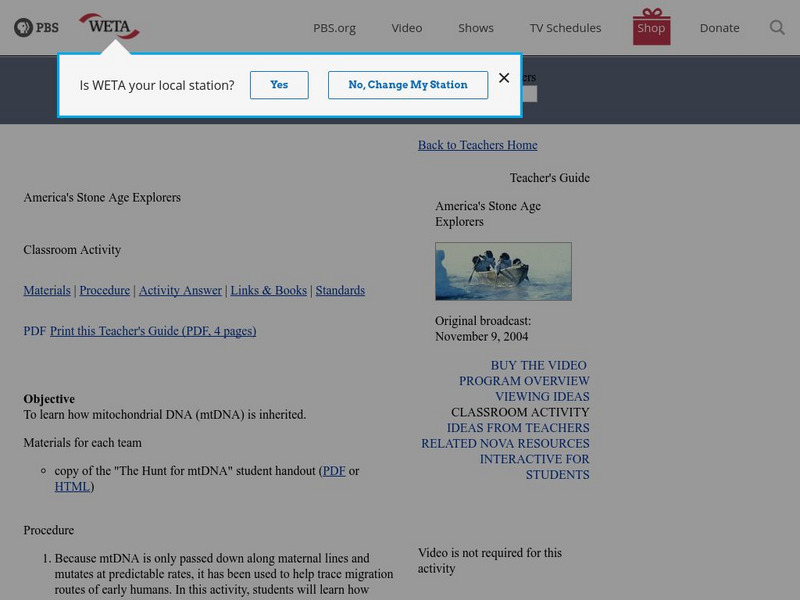Science Education Resource Center at Carleton College
Serc: Chromatography: Who Wrote the Note?
Students investigate who stole the class pet by testing the chromatograph of different markers as a way to find the evidence that points to the perpetrator.
PBS
Pbs Teachers:america's Stone Age Explorers
Discover how mitochondrial DNA (mtDNA) is inherited, and complete a pedigree chart by determining which individuals might share mtDNA with an unknown ancestor.
Rice University
Rice University: N Squad: Alcohol and Body Systems
Three problem-solving detective games involve players in investigations of the effect of alcohol on the body's digestive, circulatory, and nervous systems.
Texas Instruments
Texas Instruments: Are Your Bones Normal?
Students can use the TI-Navigator to investigate mathematics in Forensic Science.
Crown Copyright (UK)
Gov. Uk: The Northern Ireland Office
This resource provides information on law and order, criminal justice, prison service, and the forensic science agency of Northern Ireland.
PBS
Pbs: Nature: Crime Scene Creatures
Become a detective with this interactive crime scene! Use tools and animals at the crime scene to help you determine the time of death of the body. By collecting specimens at the scene, students try to determine how long the person has...
PBS
Pbs Learning Media: Dna on the Witness Stand
Dr. Eric Lander of the Human Genome Project explains the use of DNA as forensic evidence. He describes the process and need for standards in testing laboratories and discusses the use of DNA evidence as a human rights tool.
University of Arizona
The Biology Project: Human Biology: Blackett Family Dna Activity
Family studies are a good way to learn about DNA profiling and RFLP analysis because students can follow the inheritance of DNA markers from one generation to the next. Students have the opportunity to do this in this activity.
University of Arizona
The Biology Project: Human Biology: Blackett Family Dna Activity 2
In this activity, students learn the concepts and techniques behind DNA profiling of the national DNA databank. Students will then have the opportunity to collect and interpret actual STR data, and to answer one or more questions.
BiologyWise
Biology Wise: History of Dna Fingerprinting
Discusses the scientists who made discoveries about DNA and those who invented and worked on DNA fingerprinting, and some of the criminal cases that were resolved or thrown out through the use of DNA evidence. (Warning: Some of these...
Michigan Reach Out
Fingerprinting: A Lesson on Classification
Who done it? Basic lesson plan to classify fingerprints. Young scholars can classify their own and classmates fingerprints by taking prints and comparing them to the handout provided.
Other
Early Fingerprinting Pioneers
This resource takes a look at some of the early fingerprinting pioneers such as Marcello Malpighi, William Herschel, Alphonse Bertillon and many more.
American Academy of Family Physicians
Family doctor.org: Autopsy: Questions and Answers
Article provides questions and answers to this procedure to educate the general public.
WebMD
Web Md: Autopsies: When Are They Done?
Why is an autopsy done? How is it done? What are the risks? Discover the answers to these questions and many more as you peruse this site.
BiologyWise
Biology Wise: Uses of Dna Fingerprinting
Explains what DNA profiling is and describes some of the many ways it is used.
Curated OER
Spectroscope, About 1920
This concise site provides a brief discussion of the invention of the first work spectroscopes and their impact on forensic science.
Curated OER
Spectroscopic Apparatus, Steel Engraving, 1869
This concise site provides a brief discussion of the invention of the first work spectroscopes and their impact on forensic science.
Curated OER
Chart Showing the Spectra of Different Types of Blood Samples, 1894
This concise site provides a brief discussion of the invention of the first work spectroscopes and their impact on forensic science.
Curated OER
Henry Enfield Roscoe, ph.d., on Spectrum Analysis, New York, 1869
This concise site provides a brief discussion of the invention of the first work spectroscopes and their impact on forensic science.
Curated OER
Beckman Du Spectrophotometer, About 1950
This concise site provides a brief discussion of the invention of the first work spectroscopes and their impact on forensic science.
Curated OER
Spectroscopes
This concise site provides a brief discussion of the invention of the first work spectroscopes and their impact on forensic science.
Curated OER
Spectroscope, About 1920
This concise site provides a brief discussion of the invention of the first work spectroscopes and their impact on forensic science.
A&E Television
History.com: 5 Iron Age Tools and Innovations
New techniques helped make iron stronger -- but there were also innovations in the use of gold, silver and stone. "The earliest iron objects in the world...start showing up around 3000 B.C.," says Nathaniel Erb-Satullo, a lecturer in...
Google
Louisiana Curriculum Hub: Ela Guidebooks: Grade 8: Written in Bone: Unit Files
A Google Drive folder with instructional presentations, discussion questions, student activities, and assessments for the text, Written in Bone.
Other popular searches
- Forensic Science Powerpoint
- Forensic Science Project
- Forensic Science Blood Type
- Vocabulary Forensic Science
- Forensic Science Lab
- Forensic Science Power Point
- Forensic Science Activities
- Forensic Science Fingerprint
- History of Forensic Science
- Forensic Science Entomology
- Forensic Science Archaeology
- Forensic Science Archeology













